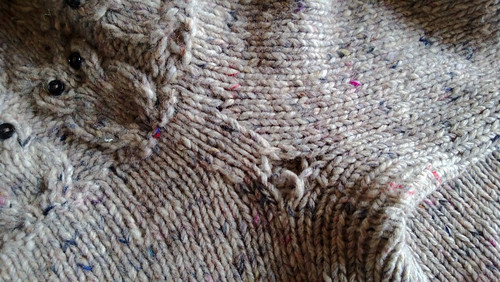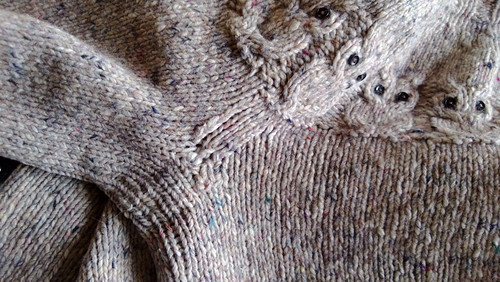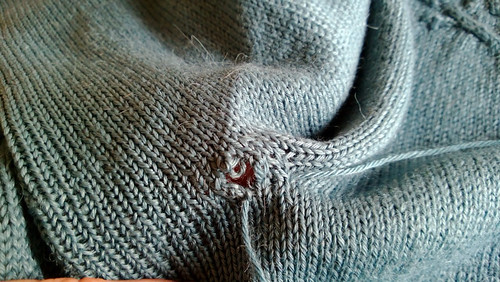Look progress! I've been knitting, dealing with the outstanding WIPs, and mending. Mending and I have an odd relationship, I make things, and I do believe that things should be mended, where practical and where possible. But when it comes down to doing mending i find it rather boring, I'd rather be knitting some new project than mending an old worn project, even when the item in question is a favorite hand knit, and I can't wear it as to do so would create more damage.
My Owl cardigan had holes in it, and a few weak spots, like this. Just where the arm and body join, at the back armscye. I noticed this at the end of last winter, and this internist upon us here in New Zealand. I diligently dug out my left over yarn and set the cardigan aside for mending. And there it sat gathering dust ...for an entire spring, summer and into autumn.
Here it is post mend, not the same hole as above, but a similar one. All mended. Part of me wanted to celebrate the repair, to follow in the footsteps of Tom of Holland with his visible mending program, or Otto van Busch, or Amy Twigger Holroyd and make a clear statement of my mending. Part of me was awa that for much of recent history in the west mended garments have been interpreted as statements of poverty and need - I wasn't sure I wanted to go there just yet. Plus I wasn't sure I wanted to subvert my Owl cardigan into a political statement about mending and repair just now ... I liked it as it was. The mends are not perfect, but are near invisible when worn. I had wondered a out darning the mend but ended up working a swiss darn/grafting style stitch over the thin areas and the holes.
With darning needle in hand, and a start made I continued on to mend the second cardigan in my mending pile. My tangled yoke cardigan, I had left over yarn, and this one had worn in exactly the same places, where the body and arms join.
Again the mend was a combination of swiss darning and grafting. Again I ended up either mending or reinforcing all four areas where the sleeve and body join. Turns out that a stitch in time is easier than a full repair! Turns out that those who came before us and did all this first are worth listening to.
I've also dug out my unfinished knitting projects, the ones that I feel guilty about. I've made progress on two. The sanquhar mitts on teeny tiny needles have grown, as has my pi shawl. I'm over half way through the second to last lace band - except it might not be second to last. I choose to knit this on finer needles and so the shawl will be denser and smaller than designed. Knowing that, and knowing the mathematics of a pi shawl I wonder if I should just add a lace repeat or two more? I have plenty of yarn ... I have four more repeats of four rounds (16 rounds) to make a decision.
All in all it seems like I am gaining ground against the mending and the WIPs that lurk around the edges of my hobby time.
Take care, na Stella
My Owl cardigan had holes in it, and a few weak spots, like this. Just where the arm and body join, at the back armscye. I noticed this at the end of last winter, and this internist upon us here in New Zealand. I diligently dug out my left over yarn and set the cardigan aside for mending. And there it sat gathering dust ...for an entire spring, summer and into autumn.
Here it is post mend, not the same hole as above, but a similar one. All mended. Part of me wanted to celebrate the repair, to follow in the footsteps of Tom of Holland with his visible mending program, or Otto van Busch, or Amy Twigger Holroyd and make a clear statement of my mending. Part of me was awa that for much of recent history in the west mended garments have been interpreted as statements of poverty and need - I wasn't sure I wanted to go there just yet. Plus I wasn't sure I wanted to subvert my Owl cardigan into a political statement about mending and repair just now ... I liked it as it was. The mends are not perfect, but are near invisible when worn. I had wondered a out darning the mend but ended up working a swiss darn/grafting style stitch over the thin areas and the holes.
With darning needle in hand, and a start made I continued on to mend the second cardigan in my mending pile. My tangled yoke cardigan, I had left over yarn, and this one had worn in exactly the same places, where the body and arms join.
Again the mend was a combination of swiss darning and grafting. Again I ended up either mending or reinforcing all four areas where the sleeve and body join. Turns out that a stitch in time is easier than a full repair! Turns out that those who came before us and did all this first are worth listening to.
I've also dug out my unfinished knitting projects, the ones that I feel guilty about. I've made progress on two. The sanquhar mitts on teeny tiny needles have grown, as has my pi shawl. I'm over half way through the second to last lace band - except it might not be second to last. I choose to knit this on finer needles and so the shawl will be denser and smaller than designed. Knowing that, and knowing the mathematics of a pi shawl I wonder if I should just add a lace repeat or two more? I have plenty of yarn ... I have four more repeats of four rounds (16 rounds) to make a decision.
All in all it seems like I am gaining ground against the mending and the WIPs that lurk around the edges of my hobby time.
Take care, na Stella





1 comment:
Oh, good for you! I have a (not handknit) favorite fine-gauge sweater with a big hole in the elbow. I have been dithering about whether to fix it in that overt way that you reference, or not. I may end up having no choice, since I don't think I'll be able to find matching yarn...
I am very behind on blog reading, but hope that all is well with you all!
Post a Comment